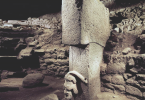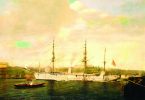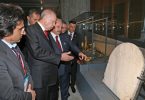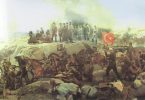The Ottoman Empire… Ali Osman, the dynasty of hundreds of years of governing more than 60 different nations under its rule, has led the way in politics as well as in many sport activities. The sports clubs of the cities that were given donations, all used the moon and crescent on their amblems or the Ottoman name for the duty of loyalty they felt for the Ottomans. One may come across this in various locations from the Balkans to the British Island. However, one of the most interesting stories is the Ottoman Cricket Team established in South Africa. A 44-Day Journey Abdulhamid II, the 34th Ottoman Sultan who was known as the Caliph of the Islamic world, was blazing the trail step by step in many works that was strengthening his country. The Sultan, who never abstained from extending a helping hand to the Muslim geographies in the farthermost lands of the world, felt the same sense of sensitivity towards the muslims in South Africa. During those years, the muslims in the South of Africa were being oppressed by the British and could not even practice their religious beliefs. In 1863, a rapid decision is made to send a Sheikh al-Islam to South Africa. Ebubekir Efendi, who was both a scientist and a religious scholar, is
appointed for this position. At the end of a rough 44 day ship voyage, they reach the Southermost point of the African continent. Cape Town, the historical city, has been discovered by Portuguese seamen in 1488. The city, which also becomes where the Dutch and British cultures are blended during that time, is introduced to the first muslims in the 1700s. The muslims, who soon build the first mosque of the city, struggle against the oppression of the Europeans in order to continue their existence on the lands. However, Sheikh Yusuf and 49
of his friends are still exiled as a result.
 The Ottomans in Cape Town Ebubekir Efendi is not welcomed by the British. However, the Sheik al Islam is adamant. Within 3 months of his arrival at Cape Town, he establishes a school and starts to raise students. The Cape Town Ottoman School is the first Islamic educational institution in the South of Africa. All of the expenses of the school is met by the Ottoman State. However, he does not find this sufficient. He also builds a mosque in the name of the caliph under much sacrifice. In a short period of seven
The Ottomans in Cape Town Ebubekir Efendi is not welcomed by the British. However, the Sheik al Islam is adamant. Within 3 months of his arrival at Cape Town, he establishes a school and starts to raise students. The Cape Town Ottoman School is the first Islamic educational institution in the South of Africa. All of the expenses of the school is met by the Ottoman State. However, he does not find this sufficient. He also builds a mosque in the name of the caliph under much sacrifice. In a short period of seven
months, he learns the local languages spoken in the region. He writes a book titled Beyanu’d Din (Testimony on Religion) that is the first Islamic work in the African language. As a result of his stay for 17 years in the region, he is able to raise hundreds of students in South Africa. So much so that his own students build a mosque in London in his own name. If one third of the three and a half million population of Cape Town today is Muslim, surely it is due to the efforts of Ebubekir Efendi and the Ottomans. Step by Step to Championship And let us come to the essential part of our story… The students of the Ottoman school in Cape Town decide to establish
a sports club for recreational purposes. During that time, cricket is the most famous sport in South Africa. The muslim students decide to play this game and put the colonialist westerners in their place. With the sponsorship of the Ottoman State, the Ottoman Cricket Club is established in 1882. The three crescents on the emblem of the team represents the presence of the Ottomans in the three continents. They put all of their efforts and work hard during their practice times. All of the sportmen train to the fullest extent.

In 1914, the Ottoman Cricket Club becomes a champion in the local league. The team has now become the representatives of all of the muslims in the continents as well as the oppressed. The Ottoman Cricket Club, which is one of the two oldest teams in South Africa, also resist against the economic problems brought by the World War I and II as well as the racist apartheid regime’es oppression. To put it fairly, the muslims take an oath to ensure that the club lives on. During the 1939-1940 season, when all believed the club had become completely bereft, they win the championship. The Ottomans are able to take the Daniels League Cup to their museum. This success was needed by all. The team rises from its ashes and run from one victory to another: 1942, 1945, 1953 and 1954 championships are all won by the Ottomans. The victory of the 1976 Big Eight Competition allows an international recognition for the team. The success of the team does not cease until the 2000s and still continues today. In short, the Ottoman Empire, which had left its remarkable mark upon an era, continues to live on with all of its contributions for historical work as well as for the arts and sports and seems that it will continue to do so.
The Cricket Team Founded by the Sheikh Al-Islam
The Ottoman Cricket Club, founded in Cape Town by Ebubekir Efendi, the Sheikh Al-Islam sent to South Africa by the Ottoman Empire, draws attention with its interesting story that goes back 133 years.









Leave a Comment